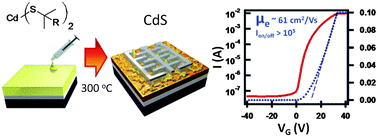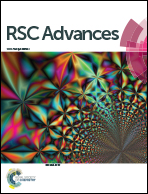Solution-processed CdS transistors with high electron mobility†
Abstract
Solution-processed CdS field effect transistors (FETs) and solar cells are demonstrated via spin-coating and thermal annealing of soluble cadmium thiolate compounds. The synthesis is carried out in one simple step using cadmium oxide and tertiary alkane thiols. The cadmium thiolates are soluble in organic solvents such as chloroform and may be spin-coated, like organic semiconductors, to form thin films. The cadmium thiolate films decompose rapidly at 300 °C to yield semiconducting cadmium sulfide films. FETs are easily fabricated using these films and exhibit electron mobilities of up to 61 cm2 V−1 s−1, which compare favourably to FETs prepared from other solution-processed materials such as organic semiconductors, inorganic nanoparticles or chalcogenide films. Initial attempts to prepare hybrid bilayer solar cells were successfully realized by spin-coating a p-type semiconducting polymer layer on top of the n-type CdS film. These devices show significant photocurrent response from both the CdS and polymer layers, indicating that the CdS films are able to participate in photo-induced electron transfer from the polymer to the CdS layer as well as photo-induced hole transfer from CdS to the polymer layer.


 Please wait while we load your content...
Please wait while we load your content...